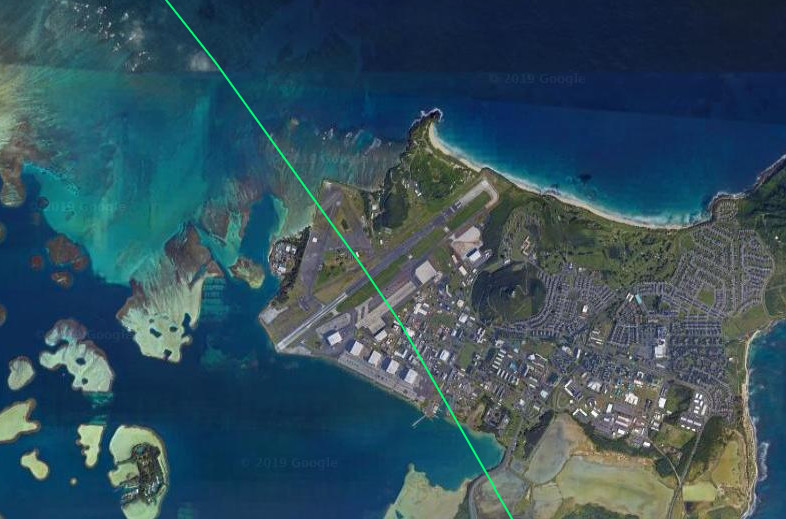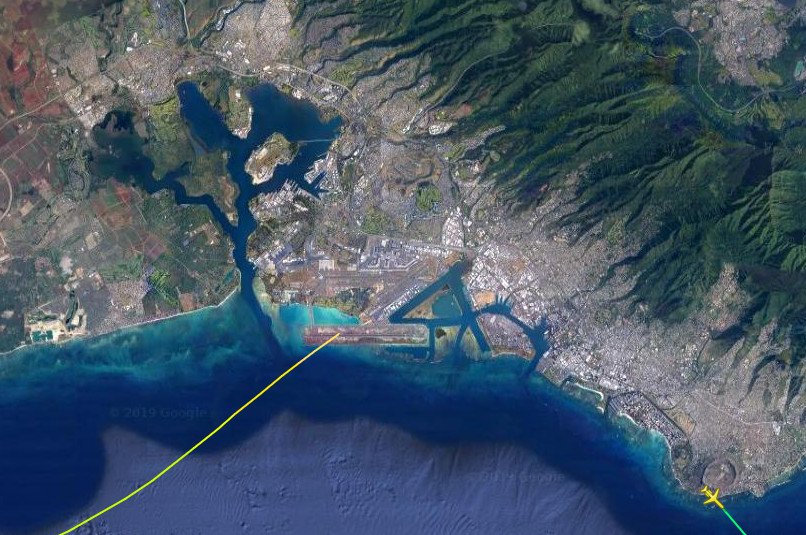The Russians are conducting their latest surveillance missions over the United States under the Open Skies Treaty, this time over Hawaii. This agreement allows member countries to perform nearly unimpeded aerial surveillance over each other’s territory, using approved sensors and in the presence of monitors from the host country. In Hawaii, the Tu-154M-ON aircraft has been photographing Hickam Air Force Base, Marine Corps Base Hawaii, the Lualualei Naval Radio Transmitting Facility, and more.
The Tu-154M-ON, which carries the registration RF-85655, left Russia on Aug. 11, 2019, and made a number of pitstops in Iceland, Canada, and the United States on its way to the Pacific. Its circuitous route took it over Chicago, where it caused something of a stir, though there is no indication it was not conducting a surveillance mission at the time. The plane was flying at around 36,000 feet and moving faster than 450 knots, far higher and faster than it typically flies when actually conducting missions. Actual flights almost always being and end a single locations, as well.
The aircraft finally touched down at Daniel K. Inouye International Airport in Honolulu on Aug. 14, 2019. The plane conducted a low-level flight around the island of Oahu that same day at an altitude of around 6,000 feet, which included passing over back over Daniel K. Inouye International Airport, as well as flying past, Hickam Air Force Base, Kalaeloa Airport, and the Lualualei Naval Radio Transmitting Facility.
Hickam Air Force Base, now part of the larger Joint Base Pearl Harbor Hickam, is a major U.S. Air Force facility in the region. The base is home to the headquarters for Pacific Air Forces (PACAF) and hosts F-22 Raptor stealth fighters, KC-135 tankers, C-17 airlifters, and more, as well as supporting various aircraft flying through for operations and exercises, including B-2 Spirit stealth bombers.

Kalaeloa was previously known as Naval Air Station Barbers Point. The U.S. Navy left as part of a Base Realignment and Closure (BRAC) process in the late 1990s, but the U.S. Coast Guard continues to maintain a presence there with HC-130 Hercules rescue aircraft and HH-65 Dolphin rescue helicopters.

The Lualualei Naval Radio Transmitting Facility, assigned to the Naval Computer and Telecommunications Area Master Station, Pacific, is a major Navy strategic communications site that operates a very low-frequency transmitter array for communicating with submarines.

On Aug. 15, 2019, the Tu-154M-ON conducted another fight, which started with a medium-altitude run at around 13,000 feet that took it over Lanai airport on the island of the same name and then over Maui Raceway Park, which occupies what used to be Puunene Army Airfield on Maui. It’s possible that this flight may have simply been for purposes of transiting to another area as neither of these sites, or any other locations along the route, have any apparent military value.

The plane eventually swung back around to fly over Marine Corps Base Hawaii (MCBH) – of which Marine Corps Air Station Kaneohe Bay is a part of – which is the service’s main base in the state.

Online flight tracking site FlightRadar24 does not specifically show the Tu-154M-ON flying over Pearl Harbor, but it does show the plane returning to Daniel K. Inouye International Airport on Aug. 15, 2019, along a path that could have taken it straight over it. If the plane did not take of it during that particular run, it will almost certainly do so before it leaves. This iconic facility remains the Navy’s premier base of operations in the Pacific and is home to a variety of specialized facilities, including naval shipyards.
The same track could have taken the plane over Fort Shafter, which is home to U.S. Army Pacific (USARPAC). None of the recorded flight data shows the plane passing over the U.S. Army’s Schofield Barracks, which is also on Oahu and is where the 25th Infantry Division has its headquarters.

Over the years, the United States and Russia have exchanged various accusations that the other is failing to meet their obligations under the agreement or is otherwise exploiting its terms, something The War Zone has covered in-depth in the past. In 2018, it looks like the treaty was on the verge of collapsing entirely. A separate spat between Russia and Georgia had brought a halt to virtually all Open Skies flights that year.
The United States also briefly refused to certify Russia’s two new Tu-214ON aircraft as being compliant with the agreement’s terms. Open Skies’ goal is to allow participating countries to routinely monitor each other’s military and military-related sites to promote transparency and reduce the likelihood of confusion about or misinterpretation of certain activities leading to an actual conflict. The U.S. government has, on a number of occasions, accused the Russians of trying to exploit the terms in order to gather more traditional intelligence.
However, the Treaty seems to be back to running as intended, at least for the time being. The Russians eventually dropped their request to overfly Georgia and the U.S. government did approve the Tu-214ONs. So, in 2019, Open Skies missions have been occurring at their normal usual rate, both in the United States and elsewhere. Already this year, Russian Open Skies aircraft have flown over a number of particularly sensitive sites, including Area 51 and Sandia and Los Alamos National Laboratories, among other locations. You can read more about the Treaty and the continuing debate surrounding it here.
Russia’s Tu-154M-ON aircraft is set to finish up its latest visit to Hawaii on Aug. 16, 2019. This may not be the last time this aircraft, or one of the Tu-214ONs, returns to the United States this year to perform another one of these intriguing surveillance missions.
Contact the author: joe@thedrive.com
